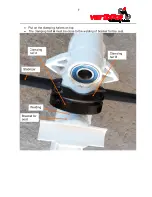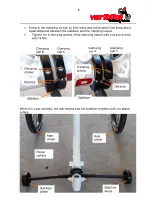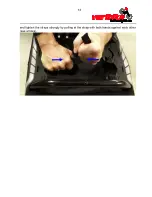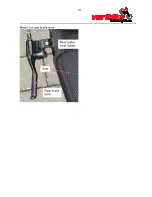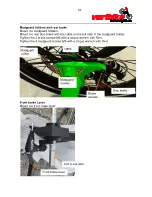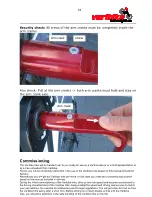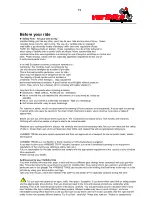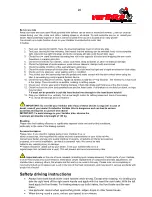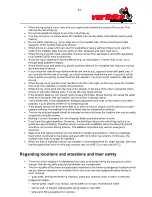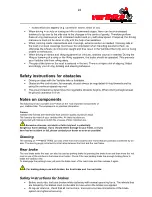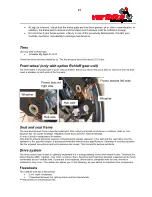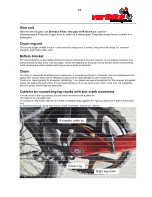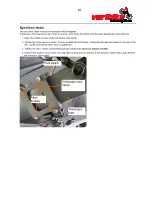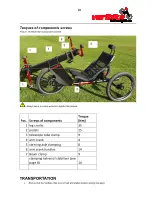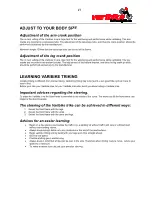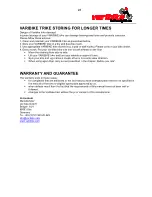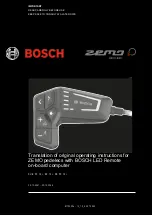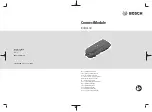
19
Before your ride
►
Safety First
–
for your own safety
Varibike triking, just like any other sport, has its own risks and sources of injury. Please
consider these rules for safe cycling. The use of a Varibike trike in regulated
road traffic is governed by locally mandatory traffic laws and regulations (Road
Traffic Act, Highway Code or similar). These regulations must be strictly adhered to
when using a Varibike trike in public traffic situations. Many communities and
countries have their own regulations concerning the use of bicycles and trikes on tracks and
trails. Please always comply with the regionally applicable regulations for the use of
forestry/countryside tracks.
In several European countries, protective helmets are
mandatory. The Varibike-Team recommends the
use of protective headgear as a matter of principle.
This is the best possible protection, even for rides,
which may not appear to be dangerous at first sight.
The majority of head injuries can be avoided or
prevented. The fit of the headgear, strap adjustment
and correct fastening is decisive. A good helmet must fit tightly without pressure
points. Take care to buy a helmet, which complies with safety standards.
Important factors/aspects when choosing a helmet:
►
Standards
–
ANSI, SNELL, ASTM and CE certification.
►
Make sure that the size matches the circumference of your head as closely as
possible.
►
Make sure your helmet is sufficiently ventilated
–
Risk of overheating!
►
Soft straps and safe, easy to open fastenings.
For reasons of safety, we do not recommend the wearing of loose trousers or loose jackets. A loose right trouser leg
or jacket arms can easily be caught in the chain /chain ring/crank system. Use protective cycle clips or tapes if
appropriate.
Before you set out, think about when it gets dark. We recommend accessory lamps, front (white) and rear(red).
Clothing with reflective panels or strips is also to be recommended.
Whatever your cycling ambitions, always ride carefully and avoid unnecessary risks, for your own sake and the safety
of others. Accept that even Varibike trikes have their limits, and respect this with an appropriate riding style.
VARIBIKE TRIKEs are pure sports equipment and thus not approved as a transport for use on public roads, streets
and squares.
VARIBIKE TRIKES are not StVZO or StVG (Austria) or VTS (Switzerland) compliant.
If you want to drive your VARIBIKE TRIKE in public transport, you must it retrofitted according to the equipment
regulations of the country (eg, reflectors, lights, bell, etc.).
You are responsible for the safe condition and comply with the appropriate regulations of the country of your Varibike
trike equipment.
Please consult your dealer.
Getting used to your Varibike trike
Your new Varibike trike may ride, steer, brake and have a different gear change when compared with your previous
bike. This is particularly the case when it is your first Varibike trike. Take some time to get used to it, and ride with
particular care in this phas
e!
The VARIBIKE TRIKE can be steered by the shifting the front frame to the right or to the
left side by using your arms and/or your legs.
Take your time to get used to this Varibike trike steering and please drive especially cautious during this time.
Try out your new gears on an open, traffic free space, if possible. If you have never used click or safety pedals
and the appropriate shoes before, then you must get used to the lock and release procedures, preferably while
standing. First of all, read the pedal system instructions carefully. You are particularly prone to accident risks if your
new Varibike trike has a totally different braking system. Modern brakes may have a much stronger, and more
immediate braking effect than the brakes you have previously been used to! It is also possible, that the right and left
brake levers now operate different brakes. Try it out first - carefully! Please also read our
“
Notes on components
“
.



